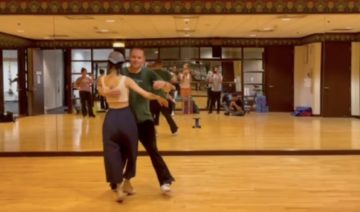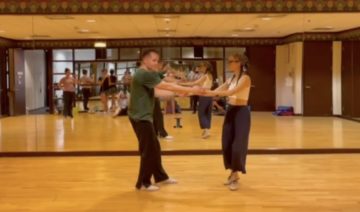Easily Learn How To Master East Coast Swing Dancing For Fun And Joy!
Wanting to know how to learn East Coast Swing? Take fun dance classes in Phoenix, AZ! There are many East Coast Swing dance lessons near Phoenix, AZ almost every night of the week! You could be learning how to East Coast Swing tonight by selecting a lesson from https://www.swingdancingphoenix.com
If you are looking for East Coast Swing dance lessons intermediate level, almost every teacher will teach a beginning East Coast Swing lesson that increases in complexity to intermediate levels by the end of the class. They are almost always followed by social dancing with people at all levels so you can practice your new skills.
Learning how to East Coast swing dance is a fun way to meet new people and have a great time. It can be overwhelming at first, but as you practice, the easier it becomes. The most common and easiest swing dance to learn is East Coast Swing. It’s a 6-count step; rock step, triple-step, triple-step.
In East Coast Swing, the standard body positions for the leader (the person initiating the steps and movements) and follower (the person following the leader’s steps and movements) are as follows:
Leader:
Feet: Should be shoulder-width apart, with the weight evenly distributed across both feet.
Upper body: Should be relaxed and upright, with the shoulders level and the arms slightly bent.
Hands: The leader typically holds the follower’s right hand in their left hand, with their right hand on the follower’s back.
Follower:
Feet: Should be shoulder-width apart, with the weight evenly distributed across both feet.
Upper body: Should be relaxed and upright, with the shoulders level and the arms slightly bent.
Hands: The follower typically places their left hand on the leader’s right shoulder, with their right hand held by the leader.


Both the leader and follower should maintain a comfortable and relaxed frame, with good posture and balance. It is important to keep the feet and body facing the direction of travel and to maintain a consistent distance between the leader and follower. Overall, the goal is to move smoothly and fluidly around the dance floor while staying in sync with the music and the partner.
East Coast Swing Dance Lessons Intermediate. Here’s Some of the Best Moves!
There are many East Coast Swing dance lessons intermediate moves that are commonly taught in swing dancing lessons near Phoenix. Here are a few examples:
- Tuck Turn: A turn pattern where the leader and follower rotate around each other, with the follower briefly tucking their foot behind their standing leg as they turn.
- Sugar Push: A step where the leader and follower push off from each other, with the follower taking a back step on the first beat and then a forward step on the second beat.
- Double Rhythm Pivot: A step where the leader and follower pivot around each other, with the follower taking two quick steps on the first beat and then two quick steps on the second beat.
- Send Out: A step where the leader and follower separate and then come back together, with the follower taking a back step on the first beat and then a forward step on the second beat.
- Whip: A step where the leader and follower spin around each other, with the follower taking three quick steps on the first beat and then three quick steps on the second beat.
These are just a few examples of the many East Coast Swing Dance Lessons intermediate dance steps that are often taught in lessons. As you progress in your dancing, you will have the opportunity to learn more advanced steps and turn patterns.
You can see some excellent example footwork here:
What Is the Difference Between East Coast Swing and Jitterbug?
East Coast Swing and Jitterbug (also called Lindy Hop) are both forms of swing dance that originated in the United States in the 1930s and 1940s. Both styles are characterized by their energetic footwork and use of swing rhythms, so what is the difference between East Coast Swing and Jitterbug?
One key difference between the two styles is their respective dance patterns. East Coast Swing is danced in a 6-count pattern, with three steps taken on one beat and three on the next.
Jitterbug, on the other hand, is danced in an 8-count pattern, with four steps taken on one beat and four on the next.
Another difference between the two styles is their respective tempos. East Coast Swing is typically danced to music in the range of 120-136 beats per minute, while Jitterbug is typically danced to music in the range of 150-180 beats per minute.
Despite these differences, East Coast Swing and Jitterbug share many similarities and are often taught and danced together. Both styles are popular at social dance events and are enjoyed by dancers of all levels. It gets mixed into Lindy all the time.
See if you can spot some 6-count steps and 8-count steps in this video from Camp Hollywood:
Still wondering how to East Coast Swing? There are a multitude of classes taught every week by dance instructors in Phoenix, Scottsdale, Mesa and Tempe. You can take private lessons, bring a partner to a lesson or enjoy group lessons.
